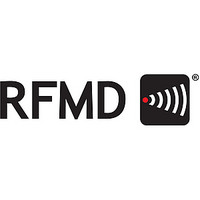RF2948B RF Micro Devices, RF2948B Datasheet - Page 11

RF2948B
Manufacturer Part Number
RF2948B
Description
2.4GHz SPREAD-SPECTRUM TRANSCEIVER
Manufacturer
RF Micro Devices
Datasheet
1.RF2948B.pdf
(18 pages)
Available stocks
Company
Part Number
Manufacturer
Quantity
Price
Company:
Part Number:
RF2948B
Manufacturer:
RFMD
Quantity:
5 000
Part Number:
RF2948B
Manufacturer:
RFMD
Quantity:
20 000
Company:
Part Number:
RF2948BSR
Manufacturer:
RFMD
Quantity:
5 000
Company:
Part Number:
RF2948BTR13
Manufacturer:
RFMD
Quantity:
5 000
Part Number:
RF2948BTR13
Manufacturer:
RFMD
Quantity:
20 000
Company:
Part Number:
RF2948BTR7
Manufacturer:
RFMD
Quantity:
5 000
Part Number:
RF2948BTR7
Manufacturer:
RFMD
Quantity:
20 000
TRANSMITTER
TX LPF and Mixers
The transmit section starts with a pair of 5-pole Bessel
filters identical to the filters in the receive section and
with the same 3dB frequency. These filters pre-shape
and band-limit the digital or analog input signals prior
to the first upconversion to IF. These filters have a high
input impedance and expect an input signal of
100mV
the I/Q quadrature upconverter mixers. Each of these
mixers is half the size and half the current of the RF to
IF downconverter on the RF2494. Recall that this
upconverted signal may drive the same SAW filter (in
half-duplex mode) as the RF2494 and therefore share
the same load. Having the sum of the two BB to IF mix-
ers equal in size and DC current to the RF to IF mixer,
will minimize the time required to switch between RX
and TX, and will facilitate the best impedance match to
the filter.
TX VGA
Being essentially high impedance, TX IF IN responds
to the input voltage (rather than power), and amplifies
that voltage by the gain specified in the datasheet, then
presents the output voltage at a 50Ω impedance (after
upconversion). For characterization purposes, a 50Ω
shunt resistor is placed on the IF signal path, before
AC-coupling to the input. A 50Ω signal source is
applied directly across the shunt resistor, through a
coaxial test lead. The signal source sees the shunt
resistor and therefore a low SWR. Voltage gain is then
the same as power gain, simply the difference in dB
between the output power and the input power.
The AGC after the SAW filter starts with a switch and a
constant gain amplifier of 15dB, which is identical to
the circuitry on the receive IF AGC. This was done so
that the input impedance will remain constant for differ-
ent gain control voltages. Following this 15dB gain
amplifier is a single stage of gain control offering 15dB
gain range. The main purpose of adding this variable
gain is to give the system the flexibility to use different
SAW filters and image filters with different insertion
loss values. This gain could also be adjusted real time,
if desired.
Rev A6 040930
PP
typical. Following these low pass filters are
TX Upconverter
The IF to RF upconverter is a double-balanced differ-
ential mixer with a differential to single-ended con-
verter on the output to supply 0dBm peak linear power
to the image filter. The upconverted SSB signal should
have -6dBm power at this point, and the image will
have the same power, but due to the correlated nature
of the signal and image, the output must support 0dBm
of linear power to maintain linearly.
+6dBm PA Driver
The SSB output of the upconverter is -6dBm of linear
power. The image filter should have at most 4dB of
insertion loss while removing the image, LO, 2LO and
any other spurs. The filter output should supply the PA
driver input -10dBm of power.
The PA driver is a one-stage class A amplifier with
10dB gain and capable of delivering 6dBm of linear
power to a 50Ω load, and has a 1dB compression
point of 12dBm. For lower power applications, this PA
driver can be used to drive a 50Ω antenna directly.
RF2948B
11-249










